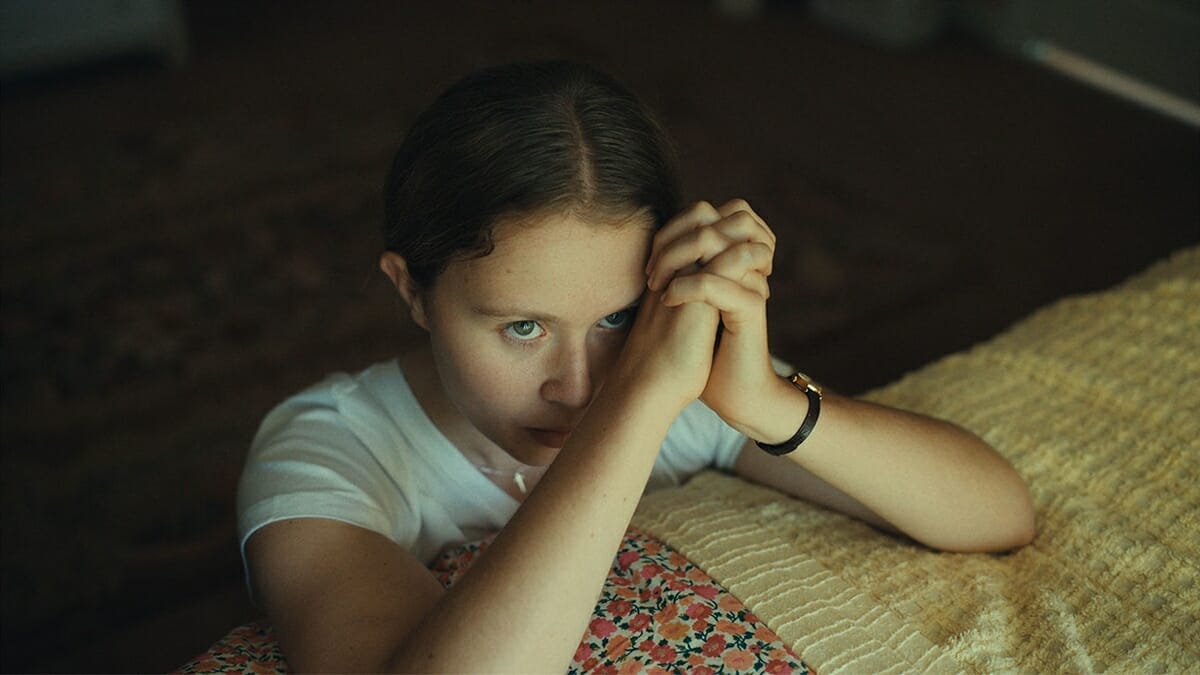Eliza Scanlen elevates her role as a lapsing fundamentalist in a drama that ends up too literal to stick out.
Jem Starling’s (Eliza Scanlen) wardrobe is too much for the Kentucky heat. Yet others say her bra is still too visible. She tries to praise the Lord through dance with attempts progressive yet accessible to her church. Still, her peers claim the music she picks is too aggressive. Her instructor, Misty (Jessamine Burgum), gently scolds her individuality in class. Meanwhile, at home, her family warns against not just sex but intimacy of any sort. Such is standard for a 17-year-old girl growing up a fundamentalist Christian. Body and soul are omnipresent in The Starling Girl, as much as they are mutually exclusive.
For Jem, these trappings ground themselves in a broader adolescence. But, for the film around her, they putter gently, amorphous when held against the script’s dramatic approaches. Laurel Parmet writes and directs her feature debut with a classicism, establishing Jem’s relationships on near-archetypal bases. Her father, Paul (Jimmi Simpson), is an ex-country musician with a drinking problem. Her mother, Heidi (Wrenn Schmidt), is a crystallization of internalized misogyny passed through generations. Virtually everyone else blurs into the background, not unlike the forests guarding whichever path Jem rides her bicycle down.

A fog seems to exist between the characters and the viewer. Maybe it’s the weather, perhaps something else. There’s little to latch on to that feels particularly new. Moreover, it’s hard to always tell if such an approach holds enough purpose. But when youth pastor Owen (Lewis Pullman) returns from missionary work, The Starling Girl gets a lift. He seems out of place in the town, but not too much. Under a perennial layer of sweat and with the perfect amount of sag, his clothing leaves just enough room for Jem’s imagination. Inevitably, the two begin meeting up in secret.
Suddenly, whatever desire lies within her has an outlet. Their sexual intimacy is refreshingly undercooked and void of revelations one may prescribe. With that, whichever emotional mechanics the film displays begin to congeal as actual pathos. The performances do the lion’s share here: Scanlen’s work is analytical yet confident when the movie calls for it. Pullman, meanwhile, has a swagger that’d titillate were the film more sensual. But while the onscreen chemistry propels the picture, Parmet’s script is too rigid and telegraphed in its attempts at drama.
The Starling Girl works best when it swings along as a collection of observations. Parmet’s direction is much more relaxed when it follows Jem’s dance troupe. She and DP Brian Lannin lightly synthesize mise-en-scène not with but in contrast to the movement of the characters’ bodies. When Jem argues with Misty in favor of her own choreography later, the dialogue examines internalized misogyny divorced from sexuality. Better yet, the writing dissects the tension implicit in its characters rather than trying to craft friction to propel the narrative.
The Starling Girl reads as unable to trust the impact of whatever irascibility runs through it.
Parmet has ample opportunities to toy with her formalism, to plumb the incongruence between the physical and the spiritual. However, she doesn’t do it enough. Instead, The Starling Girl telegraphs Jem’s external conflicts, namely as they pertain to her domestic life. Quieter interactions between Jem and her mother provide a reprieve, but her father’s worsening alcoholism offers little substance. While Scanlen wrangles the film’s tone, The Starling Girl reads as unable to trust the impact of whatever irascibility runs through it. It leans toward predictable, the stakes becoming needlessly high in execution.
That humidity that hangs at an arm’s length is too much to look over. Its need to have a cut-and-dry plot sands down its sharpest moments of clarity. Its runtime, slightly protracted at just under two hours, dilutes its observation similarly. As a tale of guilt, one can’t help but think of its clearest inspirations instead. There’s a lot of Mustang here, a good amount of Breaking the Waves there. Parmet’s strongest moments as a filmmaker come in deconstructing internalized misogyny, namely in solitary moments. It’s something of a shame, then, that it feels too mannered to fully work in the end.
The Starling Girl dances into limited release on May 12.

